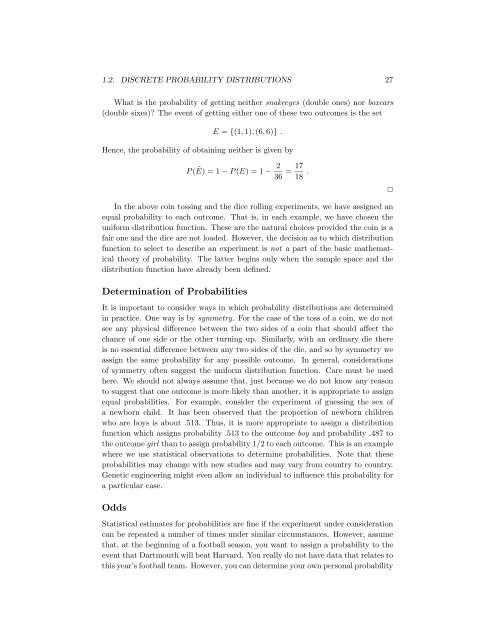Chapter 1 Discrete Probability Distributions - DIM
Chapter 1 Discrete Probability Distributions - DIM
Chapter 1 Discrete Probability Distributions - DIM
- No tags were found...
You also want an ePaper? Increase the reach of your titles
YUMPU automatically turns print PDFs into web optimized ePapers that Google loves.
1.2. DISCRETE PROBABILITY DISTRIBUTIONS 27What is the probability of getting neither snakeeyes (double ones) nor boxcars(double sixes)? The event of getting either one of these two outcomes is the setE = {(1, 1), (6, 6)} .Hence, the probability of obtaining neither is given by2P (Ẽ) =1−P(E)=1−36 = 1718 . ✷In the above coin tossing and the dice rolling experiments, we have assigned anequal probability to each outcome. That is, in each example, we have chosen theuniform distribution function. These are the natural choices provided the coin is afair one and the dice are not loaded. However, the decision as to which distributionfunction to select to describe an experiment is not a part of the basic mathematicaltheory of probability. The latter begins only when the sample space and thedistribution function have already been defined.Determination of ProbabilitiesIt is important to consider ways in which probability distributions are determinedin practice. One way is by symmetry. For the case of the toss of a coin, we do notsee any physical difference between the two sides of a coin that should affect thechance of one side or the other turning up. Similarly, with an ordinary die thereis no essential difference between any two sides of the die, and so by symmetry weassign the same probability for any possible outcome. In general, considerationsof symmetry often suggest the uniform distribution function. Care must be usedhere. We should not always assume that, just because we do not know any reasonto suggest that one outcome is more likely than another, it is appropriate to assignequal probabilities. For example, consider the experiment of guessing the sex ofa newborn child. It has been observed that the proportion of newborn childrenwho are boys is about .513. Thus, it is more appropriate to assign a distributionfunction which assigns probability .513 to the outcome boy and probability .487 tothe outcome girl than to assign probability 1/2 to each outcome. This is an examplewhere we use statistical observations to determine probabilities. Note that theseprobabilities may change with new studies and may vary from country to country.Genetic engineering might even allow an individual to influence this probability fora particular case.OddsStatistical estimates for probabilities are fine if the experiment under considerationcan be repeated a number of times under similar circumstances. However, assumethat, at the beginning of a football season, you want to assign a probability to theevent that Dartmouth will beat Harvard. You really do not have data that relates tothis year’s football team. However, you can determine your own personal probability
















